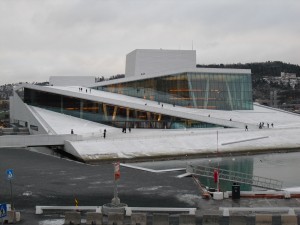In Oslo, an Ultramodern Makeover
Hermansson has lived in Oslo since emigrating from Sweden in 1992. He opened Shadowland Records in 1998, specializing in gothic and electronic music. Located on Storgata, one of Oslo’s busiest shopping streets, the store is in an easy-to-miss alley next to a shopping mall. I came upon it by chance, having become lost after grabbing a bite to eat at a 1950s themed American deli, and knew instantly that I’d found something unique: stores devoted to this type of music – a genre with admittedly few fans – are rare, and usually only found exclusively in much larger cities like New York or London. Its mere existence was a sign of Oslo’s evolution.
“It’s the oil,” Hermansson told me. “Everything goes back to oil.”
Hermansson first came to work in the lucrative oil fields of arctic Norway, and decided to settle in the country for good. Largely unaffected by the worldwide economic recession, Norway has been banking on energy for decades. First, it was timber; later, hydropower. Now it’s oil.
In August, Norway’s daily oil production was more than 2.3 million barrels per day, placing it ninth worldwide, just behind Iraq and above other oil-rich nations such as Nigeria and Venezuela. Most of it comes from offshore wells in the North Sea, where there are an estimated 6.7 billion barrels in reserves.
In 2007, the state-controlled Norwegian energy companies Statoil and Norsk Hydro merged to form Statoil ASA, which today is the largest offshore oil and gas company in the world. With operations in 21 countries, it is ranked by Fortune as the 36th-largest company on earth, and the biggest in Scandinavia. Employing more than 29,000 people, the Stavanger-based company pours more than $3.5 billion into the Norwegian economic machine every year.
Hermansson decided to leave the oil fields because he wasn’t completely happy.
“I’d seen a couple of accidents, and didn’t want to spend the rest of my life on a rig,” he said. “I just wanted to make some money and start my business.”
The first few years were difficult for Hermansson and Shadowland. With rent along Storgata being among the highest in the Nordic countries, business simply wasn’t brisk enough in the small, low-ceilinged store. But around 2004, things began to change.
“More and more people started coming in,” Hermansson told me. “It was strange, because most stores of this kind were closing [due to online downloading instead]. But they kept coming in somehow. I was able to start putting on shows [by bringing bands to local clubs] and last year was one of my best years ever [for business].”
According to Hermansson, there are only a few dozen record stores worldwide that he knows of that sell gothic music, and his is the only one in Scandinavia. Shadowland’s growth, he believes, is directly related to Oslo’s emergence as a destination for cultural digestion, including exposure to various subcultures.
“When I first came here, there really wasn’t a subcultural element to Oslo,” explained Hermansson, his Swedish accent virtually indiscernible from lifelong residents. “As the city has grown, the scene here has grown as well. Now we’re one of the biggest in Europe.”
Turid Melhus, 24, has lived in Oslo her entire life. “There’s definitely been a lot of change here,” she said, her English easier to understand than almost any New Yorker.
Melhus is a bartender at 34 SkyBar, a posh bar located on the 34th floor of the Radisson Blu Plaza Hotel. At 117 meters (384 feet), the building is the tallest in Norway, and the third-tallest in Scandinavia. Inside, its sleek, futuristic design is a microcosm of Oslo’s aspirations.
“When I was a little girl, there were very high taxes,” Melhus told me as I sipped an Irish coffee over the glass-topped bar. The crowd, mostly middle-aged foreigners, was elegantly subdued, the legato crooning of Frank Sinatra’s “New York, New York” wafting over glass tables and plush red chairs. “But the taxes helped pay for many things that have been built here, and now business is taking over and paying for it,” Melhus added. “None of this existed when I was young. It almost seems like it sprouted overnight.”
To the uninformed, it may seem that way indeed. As night descended on the city, the temperature outside was beginning to dip, little snowflakes fluttered by the floor-to-ceiling windows like flecks of dust that had been disturbed, and suddenly, I realized the symbolism of the moment.
“There may be a furious storm outside,” Melhus told me as I nursed my coffee, “but when you come here you know you are in heaven.”
I smiled. So that’s what Oslo aspires to be: heaven. With the World Snowboarding Championships taking place in February 2012 (an event which has unsurprisingly sparked a construction boom of its own, and occurring at the same time as the highly underrated Oslo Fashion Week), the world may begin to see the results of the makeover.
“The changes have been unbelievable,” Melhus said. “In another 20 years, I probably won’t recognize the way it is now.”
If Oslo’s transformation continues at its current pace, she may be right.


